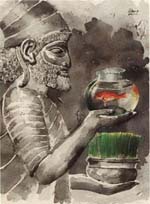| Parsi Festivals |
 |
The Parsi community, small in number, is confined by and large, to the city of Mumbai. The Parsis have many festivals but no pilgrimage sites as such. The festivals are not marked by grand processions and music as is common to most of the other religions. According to the Parsis there are six seasons in a year and a significant festival occurs in each. The Gahambars, as the festivities are called were originally agricultural in nature, but as Zoroastrianism spread far and wide, they took on a religious significance.
Each day of the year is recognised as a day under the supervision of an angel while a festal day feel under the care of a group of angels. Each holy day is divided into five watches, presided over by five angels. The first Gahambar comes around on the eleventh day of the Parsi month 'Ardibenesh', the second on the eleventh of 'Tir', the third on the twenty-sixth of 'Shehnever', the fourth on the twenty-sixth of 'Meher', the fifth on the sixteenth of 'Dai' and the sixth on the first of 'Gatha'. The Gahambars are days of great feasting and get-togethers.
Pateti
The New Year day of the older school of the Parsis, Pateti falls somewhere in September. Wearing new clothes, the Parsis offer prayers at the temples, give alms and arrange sumptuous feasts at their homes.
|
 |
Khordad Sal
The birth anniversary of Zoroaster, Khordad Sal is celebrated on the sixth day of the Parsi month, Farvardin, by offering prayers at the temples.
|
Zarthost No Deeso
This day is observed as the death anniversaryof the prophet Zoroaster, who is believed to have died in a temple while praying. The day is an occasion of mourning, and discourses are held on the life and works of the Prophet.
|
 |
Jamshed Navroz
Some Parsis follow the Fasli calendar and their New Year commences with the Vernal Equinox. The New Year celebration dates back to the times of the legendary king of Persia, Jamshed. It is said, that King Jamshed introduced solar reckoning into the Persian calendar, and also determined the date when the Sun enters the constellation of Aries, as the beginning of the year. This day came to be known as Navroz or Jamshed Navroz day. On this occasion, it was customary for the king to be weighed in gold and silver, and the money was then distributed to the poor.
|
|
|
| Religions |
In India, religion is a way of life. It is an integral part of the entire Indian tradition. For the majority of Indians, religion permeates every aspect of life, from common-place daily chores to education and politics. Secular India is home to Hinduism, Islam, Christianity, Buddhism, Jainism, Sikhism and other innumerable religious traditions. Hinduism is the dominant faith, practised by over 80% of the population. Besides Hindus, Muslims are the most prominent religious group and are an integral part of Indian society. In fact India has the second largest population of Muslims in the world after Indonesia.
|
| Read more about Indian Religions |
|
|
